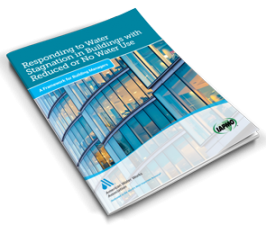A GUIDE TO PLUMBING AND MECHANICAL CODES FOR MUNICIPAL LEADERS
Plumbing is one of those things you never think about until things go wrong.
You expect clean water from a faucet. You expect a toilet to flush. Who really thinks about what it takes to bring clean water in and take dirty water out?
Until there’s a crisis. Drought. A natural disaster. A pandemic.
Municipal leaders need evidence-backed solutions to know how to minimize risks while being a good steward of public dollars.
That’s why IAPMO created this guide to help you make sense of today’s sophisticated water-related technologies and to understand the impact of your plumbing code decisions on the personal safety and economic interests of your constituents. We will keep this resource updated so check back frequently or subscribe below for updates.
CONTENTS:
ADDITIONAL RESOURCES:
-
LEARN HOW PLUMBING SYSTEMS PROTECT PUBLIC HEALTH AND SAFETY
-
LEARN MORE ABOUT PLUMBING CODES: HOW THEY ARE DEVELOPED AND DIFFERENCES AMONG MODEL CODE BODIES
Keep Buildings Safe From Legionella
Legionella is a serious concern with COVID-19 pandemic-related building shutdowns, because the bacterium grows quickly and multiplies in warm water, especially water that has been stagnant.
Learn more about Legionella and Legionnaires’ disease.
Help Home Builders Save on Construction Costs with our Water Demand Calculator
Did you know that it’s still common practice to use a pipe-sizing formula from the 1940s? You may have noticed we use a lot less water in our homes than we did 80 years ago!
Getting pipe sizing right delivers real cost savings to builders since builders are charged by the size of the meter. Reducing an inch-and-a-half meter into a house to a one-inch meter saves home builders–and ultimately homeowners–several thousand dollars per unit.
IAPMO research led to the first statistically-based update to the pipe sizing formula and integrated it into the Uniform Plumbing Code. The spreadsheet calculator is available for free to all builders, however.
Learn more about the research behind the Water Demand Calculator from Green Builder.
Read the Uniform Codes for Free Online
The Uniform Codes are on record as the codes that protect public health and safety at the lowest lifetime costs for homes and buildings.
- Read the 2021 Uniform Plumbing Code online
- Read the 2021 Uniform Mechanical Code online
- Review earlier editions, as well as the Uniform Swimming Pool, Spa, and Hot Tub Code and the Uniform Solar, Hydronics & Geothermal codes
Access Free Jobsite Support
Do you know about our toll-free job site support? For communities that use the Uniform Codes, IAPMO provides live technical support for questions on job sites that mitigate costly construction delays. This is available to anyone in a Uniform Codes jurisdiction, not just IAPMO members. Share this resource with construction professionals in your municipality.
Resources & Tools
IAPMO resources are available to assist jurisdictions, building owners, and workers keep buildings safe from water-borne pathogens and conserve water.
Keep Buildings Safe from Legionella

Legionella, the bacterium that causes Legionnaires’ disease, grows quickly and multiplies in warm water, especially water that has been stagnant. This is why Legionella is a serious concern with COVID-19 pandemic-related building shutdowns. Learn how to safely reopen buildings and protect workers.
Mitigation Strategies for Drought

Is water scarcity an issue in your region? Finding the right balance between conserving water, user satisfaction, and safety is best achieved through strong uniform plumbing codes informed by science and proven effective in the field. Learn how to access IAPMO’s WE•Stand model code, along with other IAPMO codes, to bring water conservation to your municipality.
Water Demand Calculator

Oversized piping systems add unnecessary construction costs, waste water and waste energy. IAPMO created the Water Demand Calculator (WDC) to estimate peak water supply demand for single- and multifamily residential dwellings. Learn how the WDC results in a 15 to 65 percent reduction in water demand estimates compared to the traditional Hunter’s Curve estimates.


